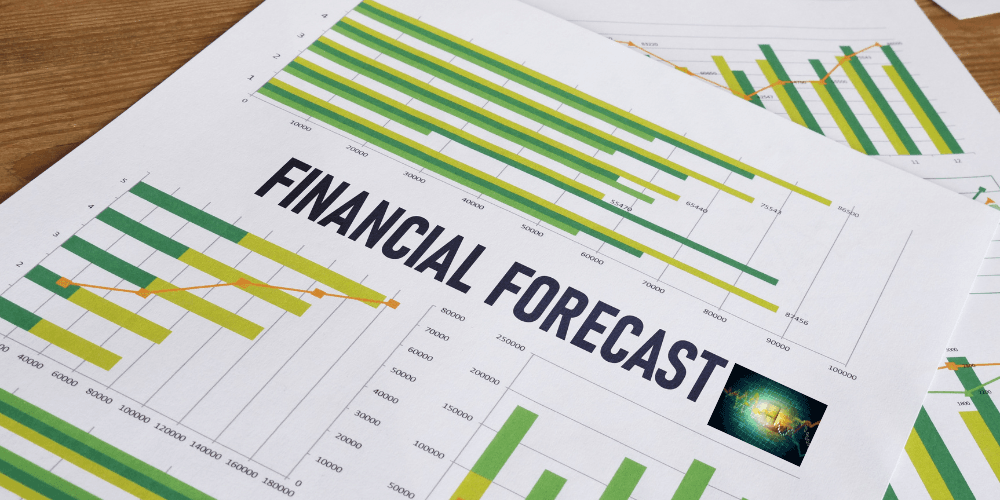In the dynamic landscape of today\’s business world, informed decision-making is paramount. Financial forecasting is a powerful tool that offers businesses a roadmap to anticipate future financial outcomes, assess risks, and make strategic choices. Let\’s delve into the world of financial forecasting, exploring its methods, benefits, challenges, and real-world applications.
What is Financial Forecasting?
Financial forecasting is the process of evaluating a company\’s future financial performance. It involves analyzing historical data, current trends, and external factors to project revenues, expenses, profits, cash flow, and other key financial metrics. These forecasts are based on a combination of quantitative analysis and qualitative judgment.
Why Financial Forecasting is Crucial in Today\’s Business World
Financial forecasting plays a pivotal role in several critical aspects of business operations:
- Strategic Planning: Forecasts provide a foundation for long-term strategic planning. Businesses can identify potential growth areas, anticipate market shifts, and make informed decisions about resource allocation.
- Risk Management: By projecting various financial scenarios, companies can assess the impact of potential risks, such as economic downturns, competitor actions, or regulation changes. It allows for proactive risk mitigation strategies.
- Financial Decision-Making: Financial forecasts inform decisions related to investments, financing, budgeting, and pricing. They help ensure that financial resources are used efficiently and effectively.
- Investor and Stakeholder Communication: Forecasts are essential for communicating a company\’s financial outlook to investors, lenders, and other stakeholders. They build confidence and trust, facilitating access to capital.
Benefits of Financial Forecasting
The advantages of implementing financial forecasting practices are numerous:
1. Enhanced Strategic Decision-Making:
- Informed Choices: Forecasts equip businesses with the data to make well-informed decisions about product launches, investments, expansions, and market entry strategies.
- Long-Term Planning: By projecting financial outcomes over extended periods, businesses can create comprehensive strategic plans that align with their long-term goals and vision.
- Scenario Analysis: Forecasting allows for exploring various \”what-if\” scenarios, helping businesses prepare for different market conditions and potential disruptions.
2. Optimized Resource Allocation:
- Efficient Use of Capital: Forecasts identify periods of potential cash surplus or shortage, enabling businesses to allocate capital strategically, invest in growth opportunities, or build reserves for lean times.
- Optimal Staffing Levels: Businesses can adjust staffing levels to meet operational needs without overstaffing or understaffing by predicting future demand.
- Inventory Management: Forecasts help optimize inventory levels, preventing excess stock that ties up capital or stockouts that lead to lost sales.
3. Proactive Risk Mitigation:
- Early Warning System: Forecasts can act as an early warning system for potential financial risks, such as rising costs, declining sales, or increased competition. It allows businesses to take preemptive action to mitigate these risks.
- Contingency Planning: With forecasts, businesses can develop contingency plans for various adverse scenarios, ensuring they are prepared to weather financial storms.
- Risk-Adjusted Decision-Making: Forecasts help businesses assess the risk-return tradeoff of various investment and operational decisions, leading to more informed choices.
4. Improved Financial Performance:
- Revenue Growth: By accurately predicting future sales and identifying growth opportunities, businesses can implement strategies to boost revenue.
- Cost Control: Forecasts highlight areas where costs can be reduced or optimized, improving profitability.
- Cash Flow Management: By anticipating cash flow fluctuations, businesses can manage their working capital effectively, ensuring they have sufficient liquidity to meet financial obligations.
5. Stronger Stakeholder Relationships:
- Investor Confidence: Transparent and credible forecasts demonstrate a company\’s financial discipline and commitment to achieving its goals, which can attract investors and boost stock prices.
- Lender Trust: Financial institutions are more likely to lend to businesses with well-prepared forecasts demonstrating a clear understanding of their financial position and future prospects.
- Employee Engagement: Involving employees in the forecasting process can increase their understanding of the company\’s financial goals and motivate them to contribute to its success.
6. Competitive Advantage:
- Agility and Adaptability: Companies that actively use financial forecasting can respond more quickly to emerging trends and market changes, giving them a competitive advantage.
- Innovation: Forecasting can help identify areas where innovation is needed to expand or maintain market share.
- Market Leadership: By consistently making accurate forecasts and delivering on financial promises, businesses can establish themselves as leaders in their industry.
Financial forecasting is a strategic tool—not just a financial exercise—that empowers businesses to make informed decisions, optimize resources, mitigate risks, and achieve sustainable growth. By embracing forecasting as an integral part of their financial management strategy, businesses can confidently navigate the complexities of the modern business environment.
Financial Forecasting Methods
Several methods are commonly used in financial forecasting, each with its strengths and weaknesses:
- Straight-Line Method: This method assumes a constant growth rate based on historical data. It is simple to use but may not account for market fluctuations.
- Moving Average: This method averages historical data over a specific period to smooth out short-term volatility. It helps identify trends but may need to catch up to sudden changes.
- Time Series Analysis: Statistical methods that analyze historical data to identify patterns and trends. It can be complex but provides valuable insights into long-term trends.
- Regression Analysis: Identifies relationships between variables (e.g., sales and advertising expenses) to predict future outcomes. It is powerful but requires careful data selection and interpretation.
- Scenario Analysis: Involves creating multiple forecasts based on different assumptions (e.g., best-case, worst-case, and most likely). It provides a comprehensive view of potential outcomes.
Financial Forecasting: Real-World Examples
Let\’s look at some real-world examples of how companies use financial forecasting:
- Apple: Apple\’s meticulous financial forecasting has significantly contributed to its ability to anticipate product demand, manage inventory, and consistently deliver strong financial results.
- Amazon: Amazon\’s forecasting models consider many factors, including customer behaviour, competitor actions, and macroeconomic trends. It allows them to make informed decisions about investments in infrastructure, product development, and marketing.
- Tesla: Tesla\’s financial forecasts have been critical in securing funding for its ambitious growth plans. Investors and lenders use these forecasts to assess the company\’s potential profitability and risk profile.
Financial Forecasting: Weighing the Pros and Cons
Pros
- Data-Driven Decision Making: Financial forecasting shifts decision-making away from gut feelings and towards data-backed insights. It allows for more objective and strategic choices, reducing the risk of costly errors.
- Enhanced Resource Allocation: By understanding future financial needs, businesses can allocate resources (capital, personnel, inventory) more effectively. It allows for more spending and underinvesting in critical areas.
- Proactive Risk Management: Forecasts illuminate potential financial risks, such as cash flow shortages, rising costs, or market downturns. This early warning allows businesses to develop mitigation strategies and contingency plans.
- Improved Budgeting and Planning: Accurate forecasts are a foundation for realistic budgeting and strategic planning. They ensure that financial targets align with achievable goals and that resources are used efficiently.
- Increased Investor Confidence: Transparent and well-supported forecasts instil confidence in investors, lenders, and other stakeholders. It can lead to more accessible access to capital and better financing terms.
- Competitive Advantage: Competitive advantage helps companies that excel at financial forecasting gain a significant edge over competitors. They can anticipate market trends, react swiftly to changes, and make informed and rational decisions that drive growth.
Cons
- Reliance on Assumptions: Forecasts are only as good as the underlying assumptions. Only accurate or overly optimistic assumptions can lead to accurate forecasts and sound decision-making.
- Data Limitations: Forecasting requires access to reliable historical data and current market information. Limited or unreliable data can hinder forecast accuracy.
- Complexity and Time Investment: Building sophisticated forecasting models can be complex and time-consuming. It may require specialized skills and software, making it inaccessible for some businesses.
- Uncertainty and Change: The business environment is inherently uncertain, and unexpected events can quickly derail forecasts. It means that projections must be regularly updated and adjusted to remain relevant.
- Potential for Overconfidence: Forecasts can lead to a false sense of security or satisfaction. Forecasts are tools, not guarantees, and should be used in conjunction with other decision-making factors.
Overall
While financial forecasting has limitations, the benefits far outweigh the drawbacks for most businesses. By investing in the right tools, expertise, and a commitment to ongoing refinement, companies can harness the power of forecasting to navigate the complexities of the modern business landscape.
Conclusion
Financial forecasting is an essential and indispensable tool for businesses of all sizes. Providing insights into future financial performance empowers companies to make strategic decisions, mitigate risks, and achieve sustainable growth. While no forecast is perfect, a well-structured forecasting process can significantly improve a company\’s financial health and competitive position.
Disclaimer
The above blog post should not be considered financial advice; it\’s for informational purposes only. Always consult with a finance-qualified professional before making any investment or business decisions.


